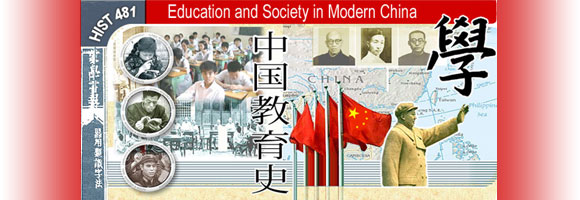
Course Outline
- Two assignments
- Final examination
- Online group discussion and participation
Course Description
History 481: Education and Society in Modern China explores selected themes in the history of Chinese education from the late imperial period (circa 1600) to the present. Topics include popular literacy; classical learning and the civil service examination system; sino-foreign interactions in education; education and gender; nationalism and education; and the educational revolution in China after 1949, including the Cultural Revolution and the post-Mao reforms in education.
Intended Audience
History 481 should be of interest not only to full or part time upper division students in History but also to students in other departments throughout the Faculty of Arts as well as students in the Faculty of Education and elsewhere. By creating an online version of the course, I hope to make the course accessible to a broad range of students, including non-traditional learners, both at UBC and around the world. There are no prerequisites for the course and no previous knowledge of Chinese history or Chinese education is required or assumed. Students taking this course will be able to study from home, work or at other educational institutions around the world, so long as they have access to a computer and to the internet.
Course Goals
Upon completion of History 481, learners will:
- Understand and be able to explain how and why education has played such a critical role in the formation of Chinese society and the search for cultural identity at different periods in China’s modern history;
- Be informed about the debates that Chinese governments along with various social and political movements and concerned individuals have waged over different conceptions and approaches toward education in China;
- Be able to situate China’s educational experience over the past century in a broad comparative and global framework;
- Be experienced in the skills of critical thinking and writing and historical analysis;
- Be experienced in the practice of online group discussion and peer evaluation;
- Have explored areas and problems in the history of Chinese education that are of particular interest to them.
Course Overview
History 481 is organized chronologically and thematically. The first two units are devoted to the late imperial period, circa 1600 to 1900. Unit 1 examines the question of literacy in late imperial China: how widespread was it; how was it acquired; what were the motives of parents, children and the state in pursuing literacy; and what did it mean to be literate in Chinese? Unit 2 looks at the role of classical learning and the civil service examination system in late imperial China, and asks how the examination system was related to politics, social structure, and the definition of elite status. Unit 3 explores the effort to forge a modern education system in China at the beginning of the twentieth century, inspired by fears of China’s weakness in the international system and the search for wealth and power. Included in this unit are discussions of the early twentieth century debate over female education and the role of Christian missionary schools. Unit 4 introduces students to the radical critique of the modern school system that emerged in China in the 1920s and 1930s as well as the various attempts by reformers to construct alternatives to the formal school system. The final three units are devoted to the educational revolution that took place in China after 1949. Unit 5 looks at the search for an appropriate development model involving efforts to learn from the experiences of the Soviet Union and from the Communist Party’s own wartime educational experiences during the War Against Japan, as well as the various debates and controversies that emerged from this search for an ideal educational model. Unit 6 is devoted to the impact of the decade-long Cultural Revolution in the educational sphere. We will see how the education reforms of the Cultural Revolution represented the culmination of tensions that had been developing for years and even decades in the educational system. Finally, Unit 7 examines the reforms in Chinese education that have taken place since the death of Mao and the re-opening of China to the world in 1978. This unit highlights not only the remarkable changes that have occurred in the past four decades but also the persistent challenges facing China’s education as it marches into the new millennium.
Course Work
Students in History 481 must complete the following compulsory activities:
- online group discussions and participation (two postings per discussion x 7 for a total of fourteen postings)
- one short position paper (3-5 typed, double-spaced pages in standard 12 point font and 1” margins) to be based upon one or more of the discussion questions listed at the end of each unit.
- one research paper (12-14 typed, double-spaced pages in standard 12 point font and 1” margins), to be based upon one or more of the discussion questions listed at the end of each unit and involving the use of at least six sources (not counting the course materials);
- final examination to be based upon the entire course (units and readings); format: long answer essay questions.
Evaluation
| Online group discussions and participation | 20 percent |
| Position paper | 25 percent |
| Research paper | 30 percent |
| Final examination | 25 percent |
Textbooks
Suzanne Pepper, Radicalism and Education Reform in 20th-Century China: The Search for an Ideal Development Model (Cambridge and New York: Cambridge University Press, 1996).
Glen Peterson, Ruth Hayhoe and Yongling Lu, eds., Education, Culture, and Identity in Twentieth-Century China (Ann Arbor: University of Michigan Press, 2001).
